Abstract
This paper investigates the efficacy of the implementation of the conventional Proportional-Derivative (PD) controller and different Active Force Control (AFC) strategies to a 5-link biped robot through a series of simulation studies. The performance of the biped system is evaluated by making the biped walk on a horizontal flat surface, in which the locomotion is constrained within the sagittal plane. Initially, a classical PD controller has been used to control the biped robot. Then, a disturbance elimination method called Active Force Control (AFC) schemes has been incorporated. The effectiveness and robustness of the AFC as “disturbance rejecter” has been examined when a conventional crude approximation (AFCCA), and an intelligent active force control scheme, which is known as Active Force Control and Iterative Learning (AFCAIL) are employed. It is found that for both of the AFC control schemes proposed, the system is robust and stable even under the influence of disturbances. An attractive feature of the AFCAIL scheme is that inertia matrix tuning becomes much easier and automatic without any degradation in the performance.
Similar content being viewed by others
References
Arimoto, S., Kawamura, S., and Miyazaki, F.: Bettering operation of robots by learning, Robotics Systems (1984), 123-140.
Arimoto, S., Kawamura, S., and Miyazaki, F.: Convergence, stability and robustness of learning control schemes for robot manipulators, in:M. Jamshidi, L. Y. S. Luh, and M. Shahinpoor (eds), Recent Trends in Robotics: Modelling, Control and Education, 1986, pp. 307-316.
Chan, C. Y.: Dynamic modeling, control and simulation of a planar five-link bipedal walking system, Master Thesis, The University of Manitoba, Winnipeg, MB, 2000.
Fujimoto, Y. and Kawamura, A.: Simulation of an autonomous biped walking robot including environmental force interaction, IEEE Robotics Automat. Mag. (1998), 33-41.
Hewit, J. R. and Burdess, J. S.: Fast dynamic decoupled control for robotics using active force control, Mechanism Machine Theory 16(5) (1981), 535-542.
Hu, J., Pratt, J., and Pratt, G.: Adaptive dynamic control of a biped walking robot with radial basis function neural networks, in: Proc. of IEEE/RSJ Internat. Conf. on Intelligent Robots and Systems, 1998, pp. 400-405.
Kun, A. and Miller, W. T.: Adaptive dynamic balance of a biped robot using neural networks, in: Proc. of IEEE Internat. Conf. on Robotics and Automation, 1996, pp. 240-245.
Lum, H. K., Zribi,M., and Soh, Y. C.: Planning and control of a biped robot, Internat. J. Engrg. Sci. 37 (1999), 1319-1349.
Mailah, M.: Intelligent active force control of a rigid robot arm using neural network and iterative learning algorithms, Ph.D. dissertation, University of Dundee, Dundee, 1998.
Pratt, J., Dilworth, P., and Pratt, G.: Virtual model control of a bipedal walking robot, in: IEEE Internat. Conf. on Robotics and Automation, 1997, pp. 193-198.
Tzafestas, S., Raibert, M., and Tzafestas, C.: Robust sliding-mode control applied to a 5-link biped robot, J. Intelligent Robotics Systems 15 (1986), 67-133.
Author information
Authors and Affiliations
Rights and permissions
About this article
Cite this article
Kwek, L.C., Wong, E.K., Loo, C.K. et al. Application of Active Force Control and Iterative Learning in a 5-Link Biped Robot. Journal of Intelligent and Robotic Systems 37, 143–162 (2003). https://doi.org/10.1023/A:1024187206507
Issue Date:
DOI: https://doi.org/10.1023/A:1024187206507




